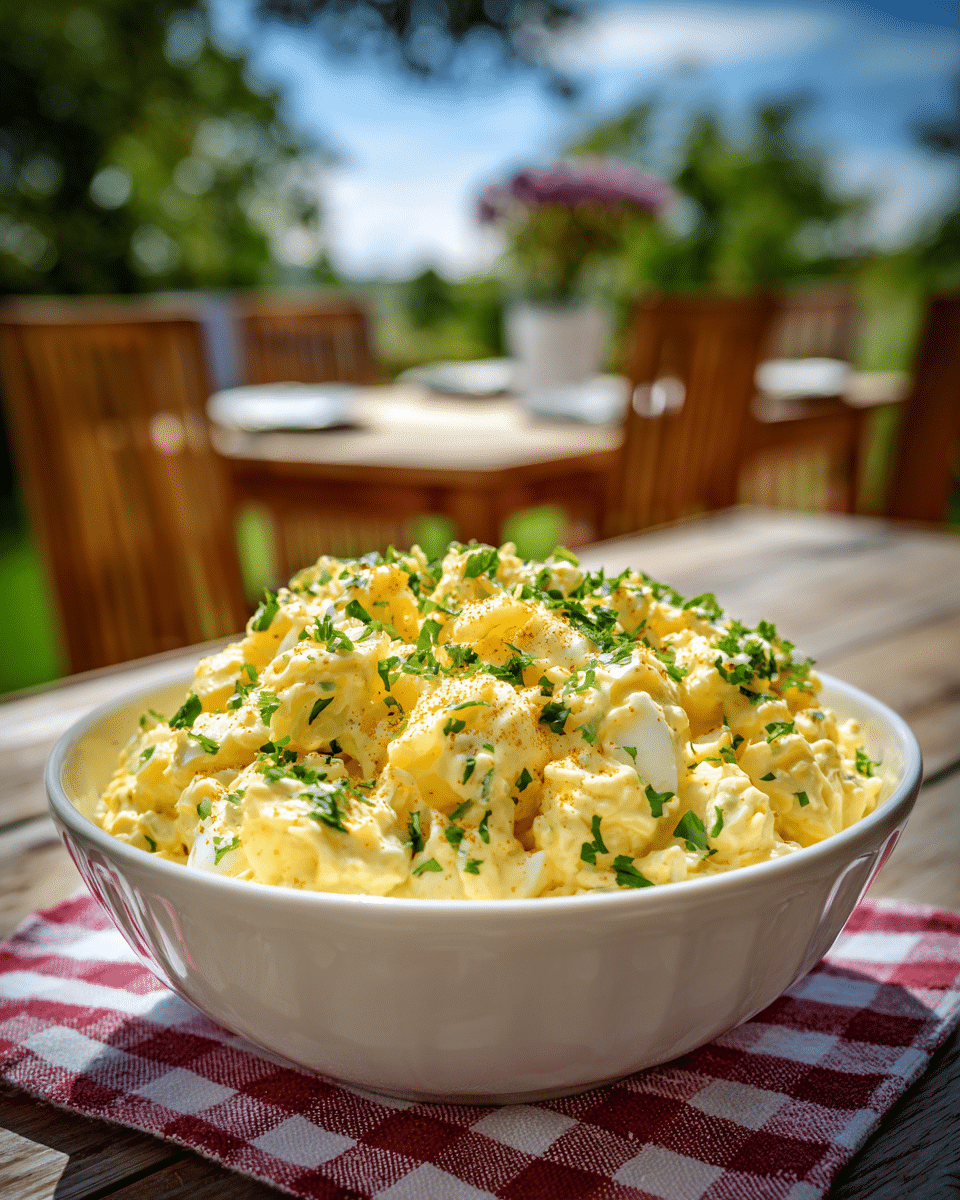This Classic Potato Salad is a timeless favorite that combines tender potatoes, crisp vegetables, and a rich, creamy dressing for a side dish that’s perfect for any picnic, potluck, or summer BBQ. Its tangy, slightly sweet flavor comes from a blend of mayonnaise, mustard, and vinegar, balanced with crunchy celery and a hint of onion. Easy to prepare ahead of time, this cold salad is a crowd-pleasing staple that complements everything from grilled meats to sandwiches.
FULL RECIPE
Ingredients
- 2 pounds (about 900g) Yukon gold or red potatoes
- 3 large eggs
- ¾ cup mayonnaise
- 1 tablespoon yellow mustard
- 1 tablespoon apple cider vinegar
- 1 teaspoon granulated sugar
- Salt and black pepper, to taste
- ½ cup finely chopped celery
- ¼ cup finely chopped red onion
- ¼ cup chopped dill pickles or sweet relish
- 2 tablespoons chopped fresh parsley (optional)
- Paprika, for garnish (optional)
Directions
- Wash and cut potatoes into bite-sized chunks (leave skin on or peel based on preference).
- Place potatoes in a large pot and cover with cold water. Add a pinch of salt.
- Bring to a boil over medium-high heat, then reduce heat and simmer for 10–12 minutes, or until potatoes are fork-tender.
- While potatoes are cooking, place eggs in a small saucepan, cover with water, and bring to a boil.
- Once boiling, cover, turn off heat, and let eggs sit for 10–12 minutes. Transfer to an ice bath, then peel and chop.
- Drain potatoes and spread out on a tray to cool for about 15 minutes.
- In a large mixing bowl, whisk together mayonnaise, mustard, vinegar, sugar, salt, and pepper.
- Add cooled potatoes, chopped eggs, celery, red onion, and pickles to the bowl. Toss gently to coat.
- Taste and adjust seasoning as needed. Refrigerate for at least 1 hour to let flavors meld.
- Before serving, sprinkle with fresh parsley and paprika if desired.
Nutrition Facts
- Calories: 290
- Total Fat: 19g
- Saturated Fat: 3g
- Cholesterol: 105mg
- Sodium: 410mg
- Total Carbohydrates: 23g
- Dietary Fiber: 3g
- Sugars: 3g
- Protein: 6g
Choosing the Right Potatoes for Classic Potato Salad
The type of potatoes you use can greatly influence the texture and flavor of your potato salad. Waxy potatoes such as Yukon Gold or red potatoes hold their shape well after boiling and provide a creamy yet firm bite, perfect for a salad that isn’t mushy. Starchy potatoes like Russets tend to break down more easily, which can make the salad too soft and gluey. For the best results, select medium-sized, evenly shaped potatoes to ensure they cook evenly.
The Importance of Cooking Potatoes Properly
Cooking potatoes to the perfect tenderness is crucial in potato salad. Overcooking can cause the potatoes to fall apart, while undercooking leaves them hard and unpleasant to eat. Simmering potatoes gently in salted water allows them to cook evenly without becoming waterlogged. Draining them well and allowing them to cool slightly before mixing helps the salad maintain a desirable texture and prevents the dressing from becoming too watery.
Role of Eggs in Enhancing Texture and Flavor
Hard-boiled eggs add a rich, creamy texture and subtle flavor contrast to classic potato salad. Besides contributing protein, chopped eggs help bind the salad together with their soft, yet slightly firm consistency. Including eggs also adds visual appeal with their bright yellow yolks interspersed throughout the salad. For the best outcome, cook eggs carefully to avoid a greenish ring around the yolk, which is harmless but can affect presentation.
The Creamy Dressing: Balancing Flavors
The signature creamy dressing of potato salad is a blend of mayonnaise, mustard, and vinegar that provides tang, richness, and a touch of sweetness. The mayonnaise offers smoothness and body, while mustard brings a mild pungency that cuts through the creaminess. Vinegar or another acidic ingredient brightens the flavors and helps balance the richness. A small amount of sugar can soften acidity and create a well-rounded taste that complements the potatoes perfectly.
Adding Crunch and Freshness with Vegetables
Incorporating finely chopped celery and red onion gives the potato salad a refreshing crunch and slight sharpness, balancing the creamy, soft potatoes. Celery adds a clean, crisp texture that contrasts nicely, while onions contribute a bit of bite and aromatic depth. Dill pickles or sweet relish introduce an additional layer of flavor with their tangy, slightly sweet notes, enhancing the overall complexity of the dish.
Herbs and Garnishes to Elevate the Salad
Fresh herbs like parsley are often added just before serving to bring a burst of color and a subtle herbal freshness. Parsley’s mild flavor complements the tangy dressing without overpowering it. A sprinkle of paprika not only adds visual appeal with its vibrant red hue but also lends a mild smoky note. Other herbs such as dill or chives can also be experimented with to tailor the salad’s flavor profile to your preference.
Serving Suggestions and Meal Pairings
Classic potato salad is an ideal side dish for many meals, especially grilled or barbecued meats such as chicken, ribs, or burgers. It also pairs wonderfully with sandwiches, fried chicken, or picnic-style meals. Serving it chilled or slightly chilled enhances its refreshing qualities, making it perfect for warm weather gatherings. Adding it to a buffet alongside coleslaw, baked beans, and fresh fruit can create a well-rounded summer feast.
Variations to Try for Different Tastes
While the classic recipe is a crowd-pleaser, there are many ways to customize potato salad. Some variations include adding bacon bits for smokiness, swapping mayo for Greek yogurt for a lighter option, or incorporating fresh dill for a more herbaceous flavor. For a Mediterranean twist, olives, sun-dried tomatoes, or capers can be included. Experimenting with these elements allows you to keep the salad exciting and adaptable to different cuisines.
Storage and Food Safety Tips
Potato salad should be refrigerated promptly after preparation and kept chilled until served to prevent bacterial growth. It can be stored in an airtight container for up to 3-4 days. Avoid leaving it out at room temperature for extended periods, especially in warm weather. Stirring the salad gently before serving can help redistribute the dressing, as some separation may occur during storage. Always use clean utensils to prevent contamination.
Nutritional Considerations and Health Benefits
While classic potato salad is indulgent due to its creamy dressing and eggs, it also offers nutritional benefits. Potatoes provide complex carbohydrates, fiber, and essential vitamins like vitamin C and potassium. Eggs contribute high-quality protein and important nutrients such as choline and vitamin B12. For those seeking a lighter version, reducing the mayonnaise or substituting part of it with Greek yogurt can lower fat and calorie content while maintaining creaminess.
History and Cultural Significance of Potato Salad
Potato salad has a rich history with roots tracing back to 19th-century Europe and America. It became popular as a versatile, easy-to-make side dish at picnics and gatherings due to its satisfying texture and ability to feed many people affordably. Different cultures have developed their own versions, using local ingredients and spices, which makes potato salad a beloved global classic. Its enduring popularity speaks to its comforting and adaptable nature.
Conclusion
Classic potato salad remains a beloved staple for gatherings, offering a perfect balance of creamy, tangy, and crunchy elements. Its simple ingredients come together to create a dish that is both comforting and versatile, easy to make yet satisfying to eat. Whether served alongside grilled favorites or enjoyed on its own, this potato salad continues to hold its place as a picnic-perfect, crowd-pleasing recipe that can be adapted and enjoyed in countless ways.






